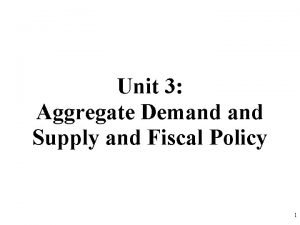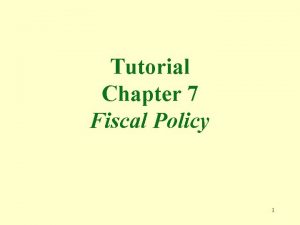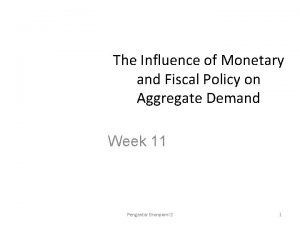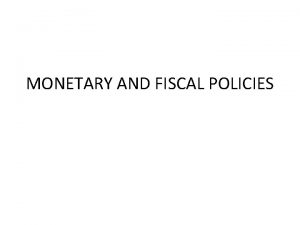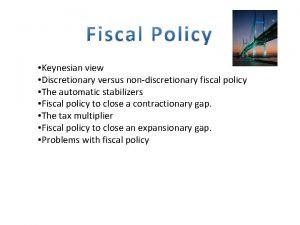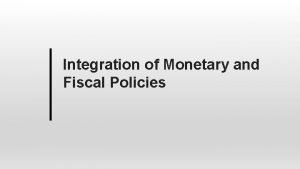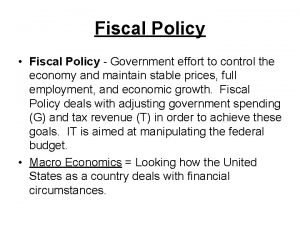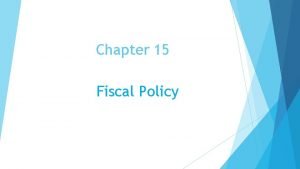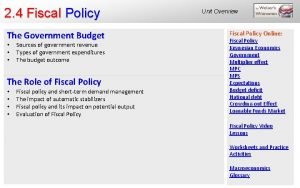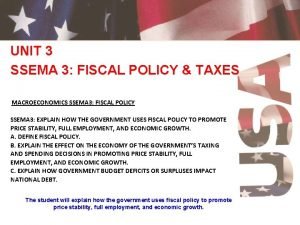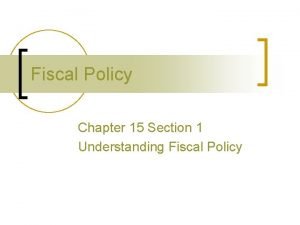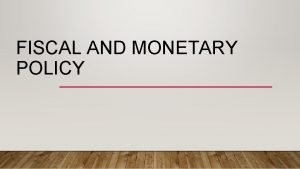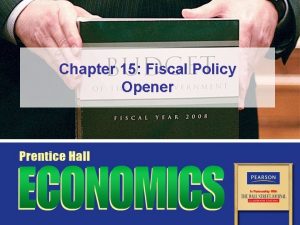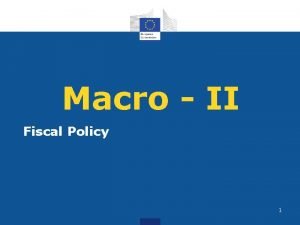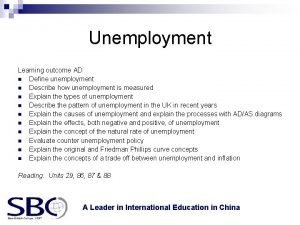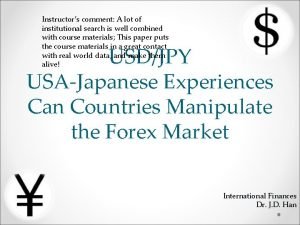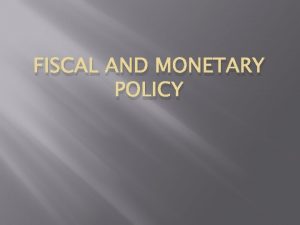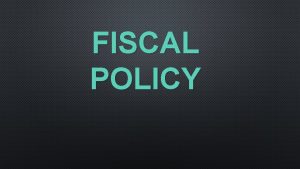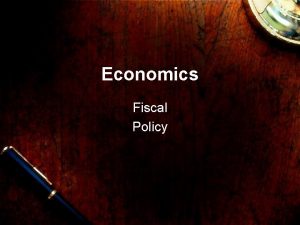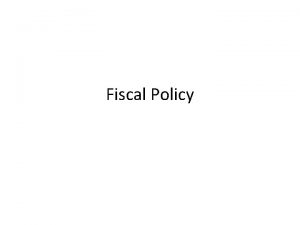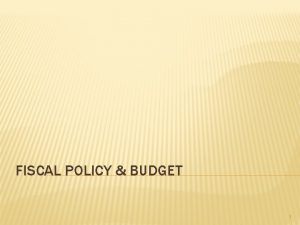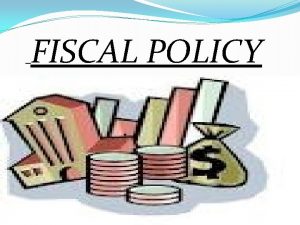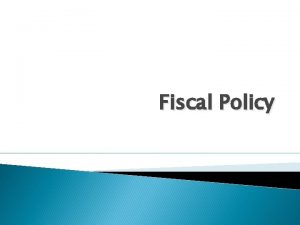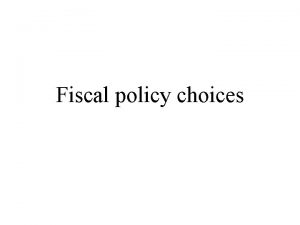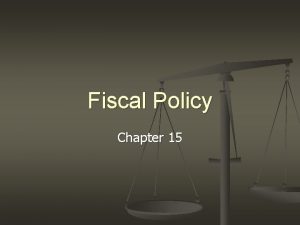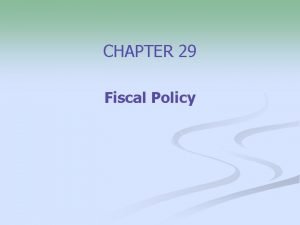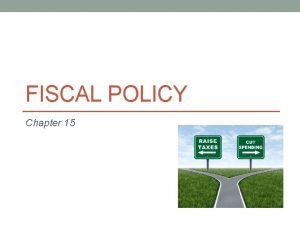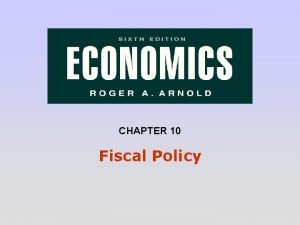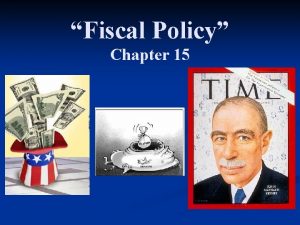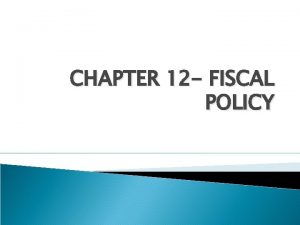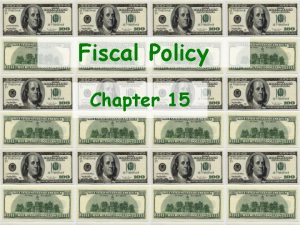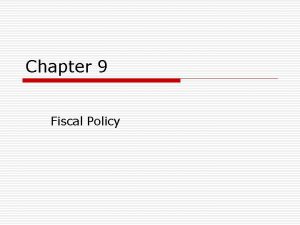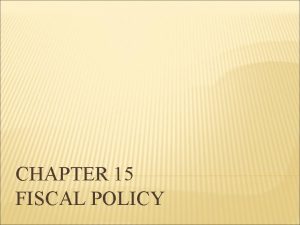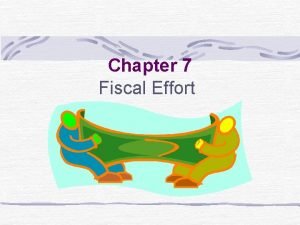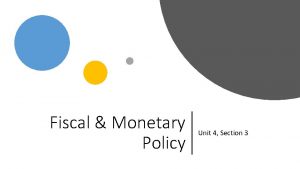Fiscal Policy Chapter 15 Section 2 Fiscal Policy





























- Slides: 29

Fiscal Policy Chapter 15 Section 2 Fiscal Policy Options

Fiscal Policy o Objectives n n n Compare and contrast classical economics and Keynesian economics. Explain the basic principles of supply-side economics. Understand the role that fiscal policy played in American history.

Fiscal Policy o o o For thousands of years, governments have collected taxes and spent money. Until the 1930 s, economists believed that a government should keep its role in the economy small. They were known as Classical Economists

Fiscal Policy o Classical Economists n n n The idea is that people in a free market economy act in their own self-interests, causing prices to rise or fall so that supply and demand will always return to equilibrium. This idea that free markets regulate themselves is as the heart of this school of thought. Adam Smith, David Ricardo, and Thomas Malthus were known for this belief.

Fiscal Policy n n n Classical Economic Thought dominated the economic theory and government policies. The Great Depression of 1929 challenged this thinking. Price fell over several years, so demand should have increased enough to stimulate production as consumers took advantage of low prices. Instead, demand also fell as people lost their jobs and bank failures wiped out their savings.

Fiscal Policy n n According to classical economists the market should have reached equilibrium, with full employment. But it did not. Millions suffered from unemployment and other hardships.

Fiscal Policy n n Many people were too poor to buy enough food for their families, while farmers lost their farms because corn was selling for seven cents a bushel, beef for 1 ½ cents a pound, and apples for five for a penny. The Depression highlighted a problem with classical economics: it did not address how long it would take for the market to return to equilibrium.

Fiscal Policy n n Classical Economists looked for a long-term solution. Hoping for long-run equilibrium. John Maynard Keynes (canes) was one economist who was not satisfied with the idea of simply waiting for the economy to recover.

Fiscal Policy o Keynesian Economics n n Keynes was from Britain. He developed a theory of economics to explain the Depression. His book The General Theory of Employment” published in 1936. Developed a comprehensive explanation of economic forces.

Fiscal Policy n n n This argument he said would tell economists and politicians how to get out of economic crisis like the Great Depression. It should also tell them how to avoid crisis in the first place. He wanted a tool that would give government that they could use in the short run.

Fiscal Policy o A Broader View n n n Keynes wanted a broader view of the country’s economy. Classical economists looked at equilibrium of supply and demand for individual products. Keynes focused instead on the economy as a whole.

Fiscal Policy n n Keynes looked at Productive capacity – often called full employment output, is maximum output that an economy can sustain over a period of time without increasing inflation. He argued that the Great Depression continued because neither consumers or businesses had an incentive to spend enough to cause an increase in production.

Fiscal Policy n n n After all, why would a company spend money to increase production when no one had enough money to buy its products. How do unemployed consumers spend money they don’t have. The only way to end the Depression would be if someone, somewhere, started spending.

Fiscal Policy n A New Role for Government o o Keynes thought the spender should be the government. In the early 1930 s, the government was the only one who had the resources to spend enough to affect the whole economy. The government could, in effect, make up for the drop in private spending by buying goods and services on its own. Keynes argued that this would encourage production and increase employment.

Fiscal Policy n n n As people went back to work, they would spend their wages on goods and services, leading to even higher levels of production. This ever-expanding cycle would carry the economy out of the depression, and the government could step back and reduce its spending. This is known as Demand-side Economics – it involves changing demand to help the economy.

Fiscal Policy n n The basis of Keynesians economics is that the economy is composed of three sectors – individuals, business, and government – and that government actions can make up for changes in the other two. Keynes argued that fiscal policy can be used to fight the two fundamental macroeconomic problems - - periods of recession/depression and periods of inflation

Fiscal Policy n n Keynes said that the government should keep track of the total level of spending by consumers, business, and government in the economy. If total spending begins to fall below the level required to keep the economy running at full capacity, the government should watch out for the possibility of an upcoming recession or depression.

Fiscal Policy n n n The government can respond by increasing its own spending until spending by the private sector returns to a higher level. The government can also cut taxes, so that spending and investment by consumers and businesses would increase. FDR carried out expansionary fiscal policy in his New Deal Program – put people to work – building dams, planting forest, constructing new schools – all paid for by the gov’t.

Fiscal Policy n Controlling Inflation o o Keynes argued that the government could use a contractionary fiscal policy to prevent inflation or reduce its severity. They can do this by either increasing taxes or reducing its own spending. Fiscal policy is difficult to control – but a powerful tool. Multiplier Effect – the idea that every one dollar change in fiscal policy (whether spending or decrease in taxes) creates a greater than one dollar change in national income.

Fiscal Policy n n n In other words, effects of changes in fiscal policy are multiplied. i. e. The US Government is putting into action a $ 150 Billion stimulus package to get Americans to spend money and stimulate the economy (Spring of 2008). Payments range from $ 600 for an individual and $ 1, 200 for a couple who file jointly. How will this affect the economy?

Fiscal Policy n n n With government putting the money into the hands of American citizens, they hope that the people will spend the money and not save it. The US Governments expects around 2/3 rds of the money to put back into the economy. About $ 100 Billion will be spent within the first six-months.

Fiscal Policy o o o Fiscal Policy is used to achieve many economic goals. One is a more stable economy. A stable economy is one in which there are no rapid changes in the economic indicators. The fluctuations in GDP occur they are not as much as before WW II. Our economy is more stable in the last 50 years.

Fiscal Policy o Reason for this? n n n Federal taxes and spending on transfer payments increased sharply. Taxes and transfer payments (cash from the Gov’t. to consumers) will stabilize the economy. When national income is high, the government collects more in taxes and pays out less in transfer payments. These actions reduce spending of consumers. The opposite is true.

Fiscal Policy o o Taxes and transfer payments do not eliminate changes in the rate of growth of GDP, but they do make these changes smaller. Taxes and Transfer Payments are called automatic stabilizers

Fiscal Policy o Supply–Side Economics n n n This stresses the influence of taxation on the economy. Supply-siders believe that taxes have strong negative influences on economic output. They believe that you increase economic growth by increasing aggregate supply (whole economy).

Fiscal Policy o o o Supply-side economists use the Laffer Curve – named after James Laffer – to illustrate the effects of taxes. This curve shows the relationship between the tax rate set by the government and the total tax revenue that the government collects. The total revenue depends on the health of the economy and the tax rate.

Fiscal Policy o o The Laffer Curve illustrates that high tax rates may not bring in much revenue if these tax rates cause economic activity to decrease. The heart of the supply-side argument is that a tax cut increases total employment so much that the government actually collects more in taxes at the new, lower tax rate.

Fiscal Policy o Fiscal Policy in American History n n President Herbert Hoover during the beginning of the Depression believed in Classical Economics and that the economy would return to equilibrium. President FDR was more willing to increase government spending to help lift the economy out of the depression.

Fiscal Policy o o US tested Keynes’ theory during WW II. The government increased spending drastically by spending large sums of money in the economy. The spending was given to the private sector. This spending helped the US economy greatly.
 Cost-push inflation
Cost-push inflation Example fiscal policy
Example fiscal policy Government expenditure multiplier formula
Government expenditure multiplier formula Components of fiscal policy
Components of fiscal policy Crowding out effect of fiscal policy
Crowding out effect of fiscal policy Unit 5 macroeconomics lesson 2 activity 45 answer key
Unit 5 macroeconomics lesson 2 activity 45 answer key Instruments of fiscal policy
Instruments of fiscal policy Expansionary gap
Expansionary gap Instruments of fiscal policy
Instruments of fiscal policy Econ crowding out
Econ crowding out Fiscal demand side policy
Fiscal demand side policy Fiscal policy to control inflation
Fiscal policy to control inflation Contractionary fiscal policy
Contractionary fiscal policy Instruments of fiscal policy
Instruments of fiscal policy Crowding out effect
Crowding out effect Demand side fiscal policy definition
Demand side fiscal policy definition Contractory monetary policy
Contractory monetary policy Crowding out effect of fiscal policy
Crowding out effect of fiscal policy Example of expansionary fiscal policy
Example of expansionary fiscal policy Fiscal policy
Fiscal policy Goals of fiscal policy
Goals of fiscal policy Fiscal vs monetary policy
Fiscal vs monetary policy Goals of fiscal policy
Goals of fiscal policy Fiscal policy
Fiscal policy Unit 3 aggregate demand and aggregate supply
Unit 3 aggregate demand and aggregate supply Unit 3 aggregate demand aggregate supply and fiscal policy
Unit 3 aggregate demand aggregate supply and fiscal policy Unemployment
Unemployment Understanding fiscal policy
Understanding fiscal policy Features of fiscal policy ppt
Features of fiscal policy ppt Fiscal policy definition
Fiscal policy definition

